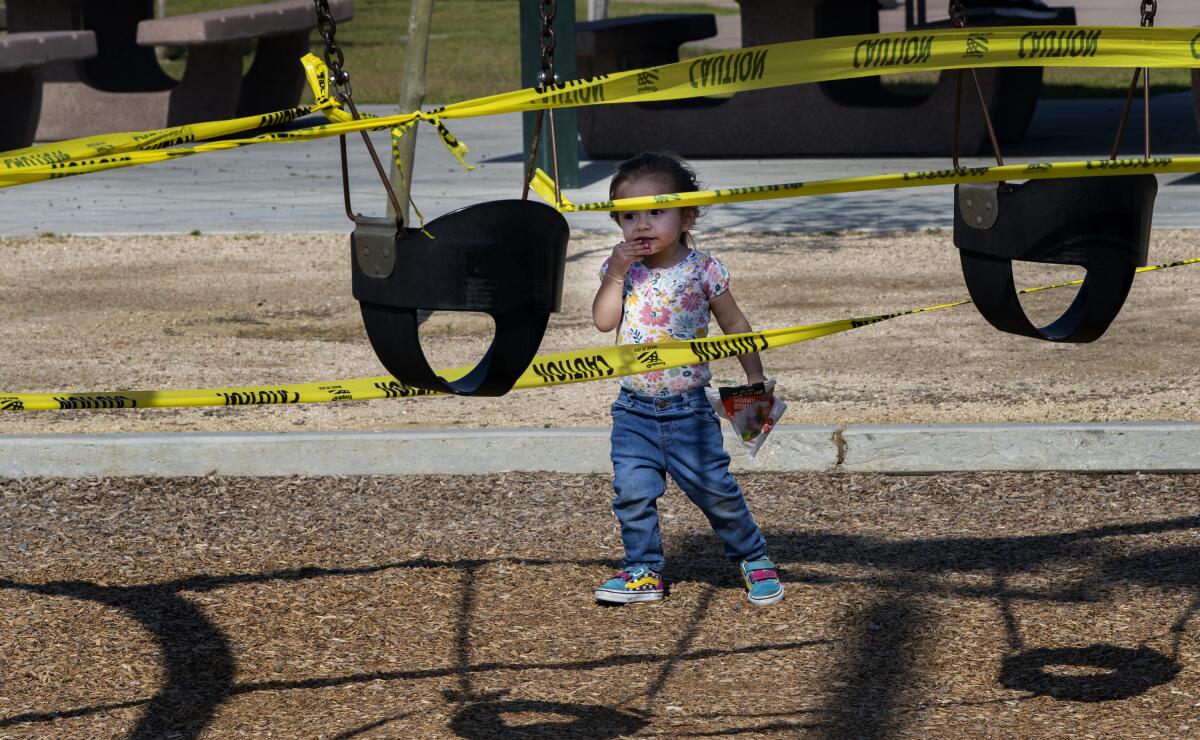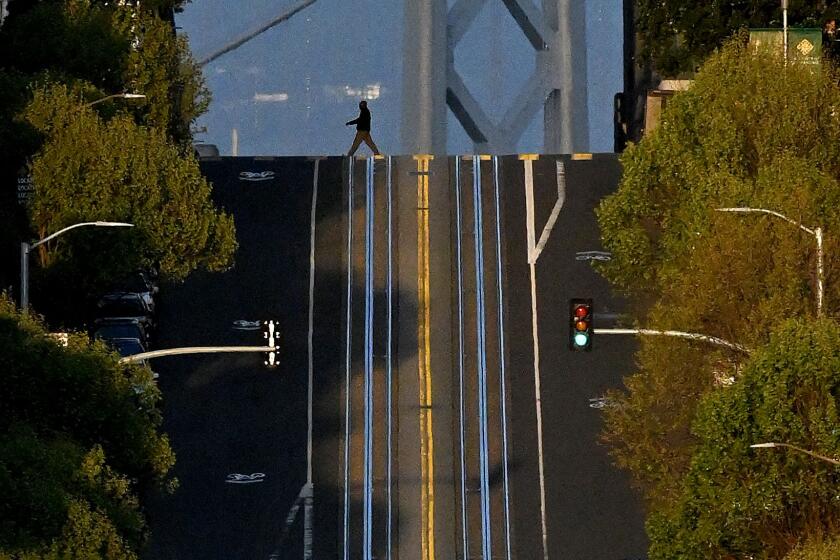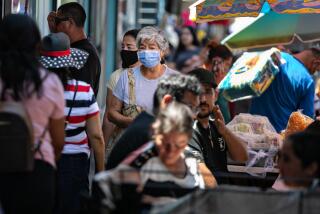We can’t shelter in place forever: How the coronavirus lockdown might end

- Share via
The coronavirus cannot keep us stuck in our homes forever.
Someday our kids will go back to school, we will return to work, and families and friends will gather once again for birthdays, holidays, weddings and funerals.
We will see movies in theaters, get drunk in crowded bars, and scream recklessly in packed sports stadiums — droplets be damned.
But how will we get from here to there? What will reentry to normal life look like? How will we ever trust the coronavirus, our unseen enemy, not to infect us at every opportunity?
As with most things related to the coronavirus, there are still many unknowns.
This virus has only been circulating in the human population for about four months. Every day scientists learn more about how it spreads, how it makes us sick, and how we might protect ourselves from getting infected in the first place.
Nobody can say for sure exactly what our return to normalcy will look like, or how long it will take to get there, but experts can offer some educated guesses.
In California, public health officials said social distancing policies will probably remain in place for months, and they warn that lifting the strict rules too early could worsen the health crisis.
They also caution that coronavirus cases are likely to rise when stay-at-home orders are relaxed.
These are some of the unusual new scenes across the Southland during the coronavirus outbreak.
Julie Swann, head of the Fitts Department of Industrial and Systems Engineering at North Carolina State University in Raleigh, said she expects the strict stay-at-home orders will be lifted before a vaccine is found — an endeavor that could take another year at least.
“If we ramp up our hospitals’ capability to deal with people who are sick, ramp up testing so we know who is sick and who has recovered, and if there is treatment that shortens hospitalization time, then we may not need to be as drastic as we are now,” she said.
Swann and other public health experts spoke to The Times about what a safe transition from our strange coronavirus reality to the regular life we yearn for could look like.
How will public health officials decide when it’s time to loosen stay-at-home restrictions?
Public health officials will want to see a drastic reduction in the number of new coronavirus infections confirmed each day before they begin to relax current restrictions, scientists said.
However, before they can feel confident that a drop has truly occurred, testing capacity must increase dramatically.
“In many states the testing capacity is still significantly behind demand, so the number of confirmed cases reported is likely to be way below the actual numbers,” said Pinar Keskinocak, director of the Center for Health and Humanitarian Systems at Georgia Tech in Atlanta.
Once widespread testing is in place, officials can better understand how many new cases there truly are, where they are, and if we are indeed in a downward trend, she said.
How low will daily new cases need to be for restrictions to be relaxed?
In California, which has a population of nearly 40 million people, stay-at-home restrictions are not likely to be relaxed until the number of new cases statewide drops below 10, said Chunhuei Chi, director of the Center for Global Health at Oregon State University in Corvallis.
“Then the state could do something like Taiwan is doing now — not totally resuming regular activity, but keeping a high level of regular activity while exercising caution,” he said.
In Taiwan, schools and businesses are still open, but people are required to wear masks on public transportation and inside enclosed areas like schools and shopping malls. Indoor gatherings must not exceed 100 people, and outdoor gatherings can be no larger than 500.
So there’s no chance things will go back to normal all at once?
A safe return to normal life is going to be incremental.
Once there has been a significant drop in new cases, local governments will be able to slowly reopen schools, shops and restaurants, Chi said.
However, shops and restaurants may be required to reduce the maximum number of people they serve at a time so customers can stay at a safe distance from one another.
The public should realize that COVID-19 cases are likely to rise when stay-at-home orders are eased, officials said.
Swann said we will probably live in a hybrid reality for several months — not quite lockdown conditions, yet not quite normalcy.
“We can expect some services to open, but not all,” she said. “We are entering a new world.”
Are we going to be wearing masks for a long time?
“Absolutely,” Swann said. “It is possible that masks will become the new seat belts.”
The primary benefit of masks is not to protect the wearer from getting sick, but to keep asymptomatic people from accidentally passing on the disease.
“I think we will see a larger percentage of Americans wearing a mask even after the acute phase of this crisis,” she said.
‘We may be moving gently at this point toward the Asian culture,’ one health expert says of everyday mask-wearing.
Chi agreed.
“People should be wearing masks until we are very sure there is no longer community spread of this virus,” he said.
He noted that new research suggests as many as 30% of people who are infected with the coronavirus are asymptomatic, while another 40% to 50% have mild symptoms that they might mistake for the flu.
“You don’t know who is infected because they look healthy and normal,” he said. “That is the most tricky part of this virus, and that’s why wearing a mask is even more critical.”
After restrictions ease, will we be asked to shelter in place again?
That largely depends on when restrictions are lifted.
“If we resume normal life too soon, the chances of seeing a second wave are higher,” Keskinocak said.
Cases are likely to rise after restrictions are loosened, Chi said.
However, local health authorities may be able to manage them by carefully tracking everyone an infected person comes into contact with, testing those people for the virus, and quarantining them if they are sick.
“If the government is meticulously tracking, testing and quarantining people, then it is still safe to meet a friend for a drink,” he said.
Does this pandemic only end with a vaccine?
Not necessarily.
Ultimately, pandemics end when a sufficient percentage of the population has immunity to a disease, either because they already had it and recovered or because they get a medical treatment that makes them immune — like a vaccine.
However, our previous lives could largely resume before that comes to pass.
“The availability of an effective treatment — which would reduce not only symptoms but also the chance of complications — would certainly help in terms of getting back to normal,” Keskinocak said.
A treatment would free up hospital beds and ventilators, and reduce pressure on healthcare personnel.
Several groups of researchers are testing different methods to divert critically ill COVID-19 patients from needing ventilators in the first place.
“The combination of widespread availability of diagnostic and serological testing along with effective treatments would help us slowly get back to normal,” Keskinocak said.
Chi agreed that life should return to some kind of normal before a vaccine is found.
“Most experts predict it will take between eight and 12 months to get a vaccine,” he said. “We shouldn’t have to wait that long.”









